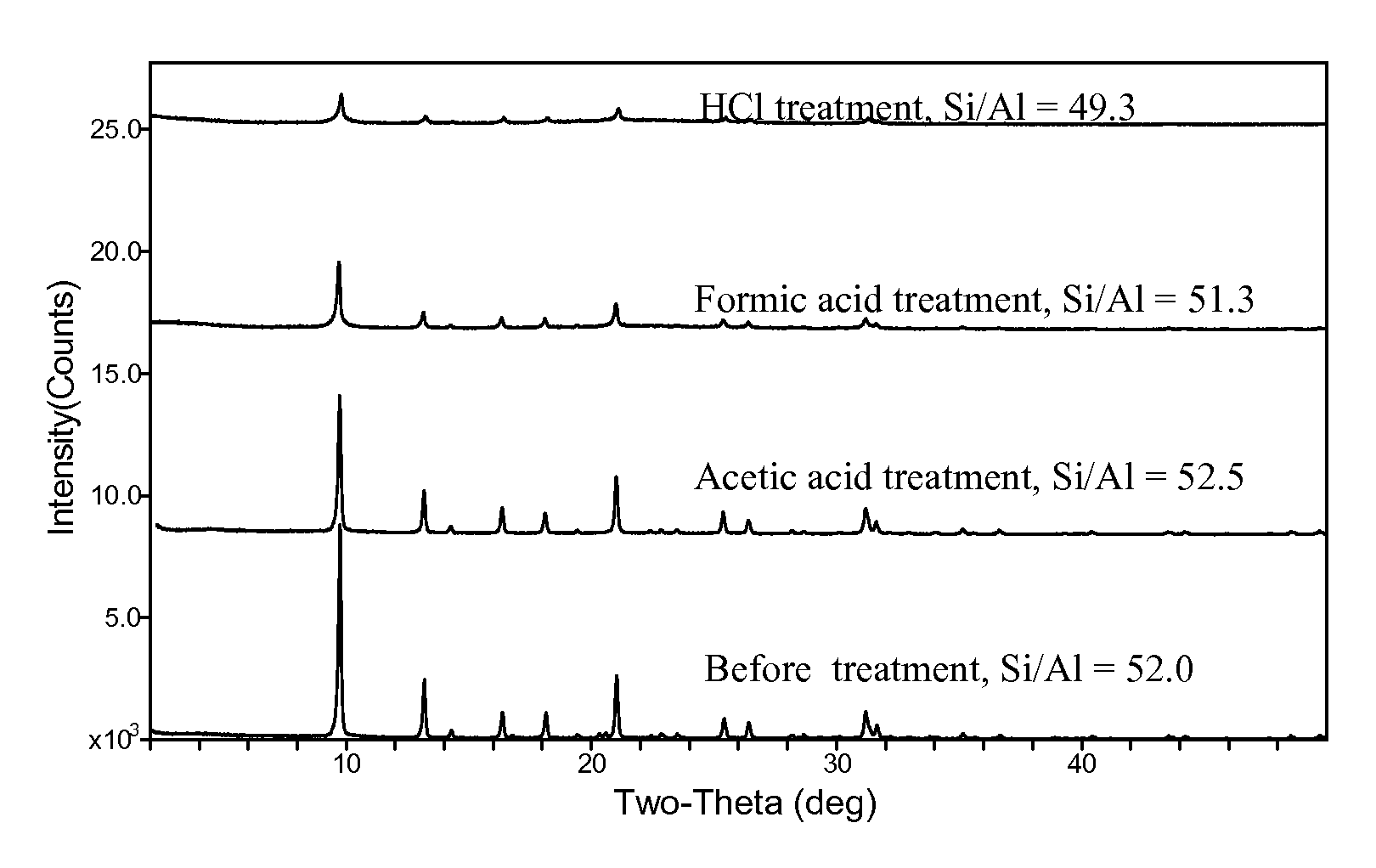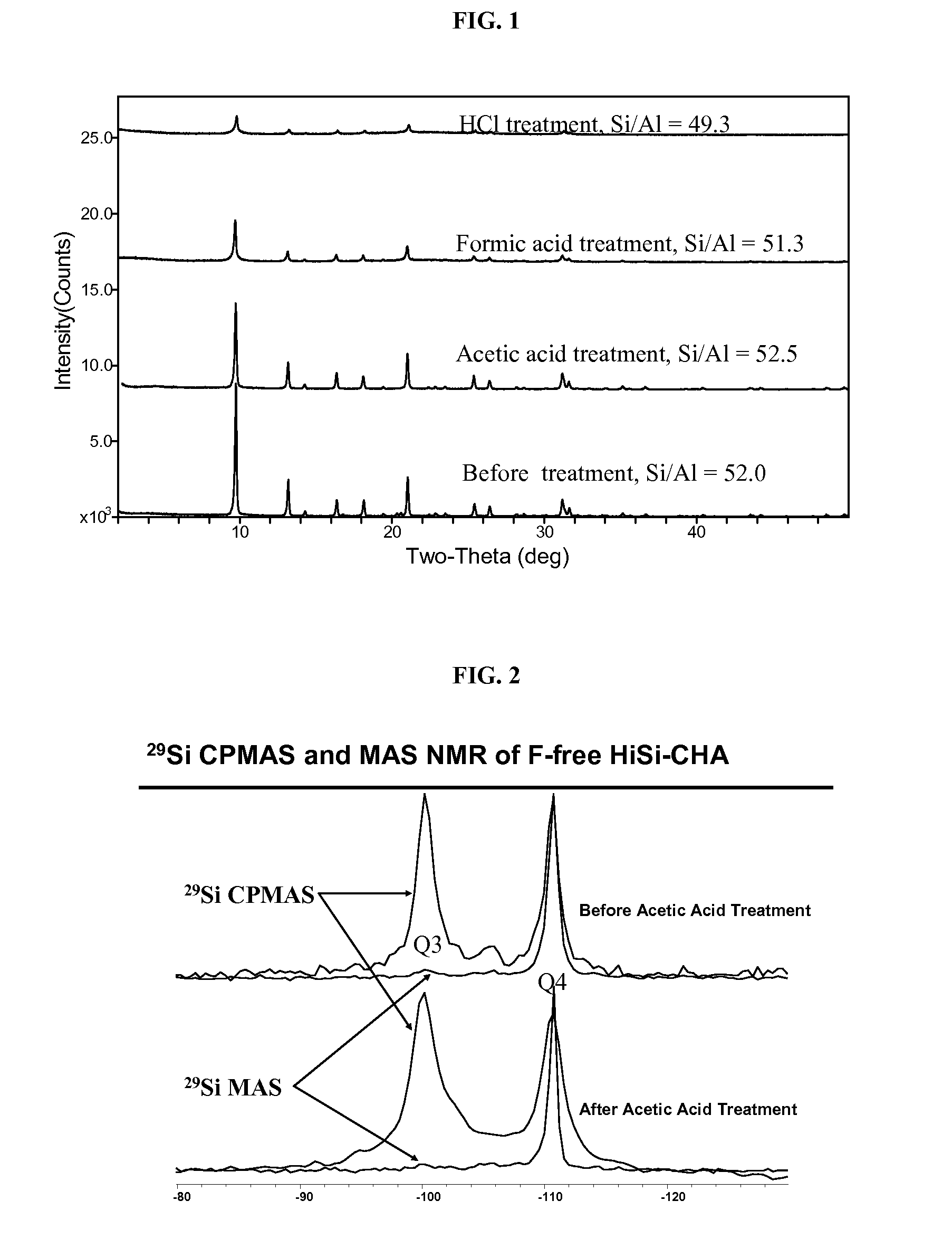Treatment Of Small Pore Molecular Sieves And Their Use In The Conversion Of Oxygenates To Olefins
a molecular sieve and molecular filter technology, applied in the field of small pore molecular filtering, can solve the problems of reducing the diffusion rate of reactants and products, increasing the potential for undesired secondary reactions, and limiting the catalyst li
- Summary
- Abstract
- Description
- Claims
- Application Information
AI Technical Summary
Benefits of technology
Problems solved by technology
Method used
Image
Examples
examples 1 to 5
Synthesis of F-Free High Silica Chabazite
[0078]The following ingredients were mixed, in sequence, and blended into a uniform gel: about 50 wt % NaOH, 42.7 wt % N,N,N-dimethylethylcyclohexylammonium hydroxide (DMECHA+OH−) solution, deionized water if necessary, Hi-Sil® 233 (PPG Industries, USA) containing about 0.53 wt % Na, about 0.01 wt % K, about 0.42 wt % alumina, and about 82.2 wt % silica, and Catapal™ A (CONDEA Vista Company, Texas, USA) which contained about 71.5 wt % Al2O3. About 200 ppm colloidal seeds having the LEV structure were added lastly. Five separate mixtures were made that had the following molar compositions:[0079]0.091 NaOH:0.182 DMECHA+OH−:x Al2O3:1.00 SiO2:6.36H2O,[0080]where x=˜0.017, ˜0.010 (two samples), ˜0.0063, and ˜0.0036
[0081]The mixtures were individually sealed in Teflon-lined Parr autoclaves and heated in a ˜160° C. oven for about 72 hours, while the autoclaves were tumbled at about 40 rpm. The autoclaves were cooled to room temperature. The contents...
example 6
Acetic Acid Treatment
[0084]About 0.54 g each of the NH4-exchanged samples above was heated to about 200° C. in a muffle furnace under flowing nitrogen for about 30 minutes. The powder was then suspended in a solution of about 4.0 g glacial acetic acid and about 10.0 g deionized water. The mixture was sealed in a ˜23-mL Teflon-lined Parr autoclave and was heated to about 180° C. for about 7 days. The resultant solid was recovered by centrifugation and washed with deionized water, and was then dried in a ˜50° C. oven. Some of the samples were subjected to the acetic acid treatment twice (designated as 2× as opposed to 1× for one-time treatment in Table 2).
example 7
Methanol-to-Olefins Performance Test
[0085]Each of the untreated chabazite samples of Examples 1 to 5 and the acetic acid treated samples of Example 6 were subjected to testing in the methanol-to-olefins (MTO) reaction in a fixed-bed microreactor. Methanol was fed at a preset pressure and rate to a reactor tube (made of stainless steel) that was housed in an isothermally heated zone. The reactor tube contained about 20 mg weighed and sized granules of the catalyst sample (20-40 mesh by the press-and-screen method). The catalyst was activated for about 30 minutes at about 500° C. in flowing nitrogen before methanol was admitted. The MTO testing was conducted at a reactor temperature of about 540° C., a methanol pressure of about 40 psia (about 276 kPa) and a methanol weight hourly space velocity (WHSV) of about 100 hr−1.
[0086]The product effluent was sampled, at different times during the run, with a twelve-port sampling loop while the catalyst was continuously deactivating. The efflu...
PUM
| Property | Measurement | Unit |
|---|---|---|
| Temperature | aaaaa | aaaaa |
| Temperature | aaaaa | aaaaa |
| Time | aaaaa | aaaaa |
Abstract
Description
Claims
Application Information
 Login to View More
Login to View More - R&D
- Intellectual Property
- Life Sciences
- Materials
- Tech Scout
- Unparalleled Data Quality
- Higher Quality Content
- 60% Fewer Hallucinations
Browse by: Latest US Patents, China's latest patents, Technical Efficacy Thesaurus, Application Domain, Technology Topic, Popular Technical Reports.
© 2025 PatSnap. All rights reserved.Legal|Privacy policy|Modern Slavery Act Transparency Statement|Sitemap|About US| Contact US: help@patsnap.com



